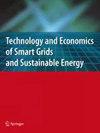Experimental Analysis of Harmonics in Traditional Lighting Sources
IF 1.5
Q4 ENERGY & FUELS
Technology and Economics of Smart Grids and Sustainable Energy
Pub Date : 2023-11-13
DOI:10.1007/s40866-023-00176-z
引用次数: 0
Abstract
The techno-economic selection of an appropriate light source poses a significant challenge in areas experiencing power and energy crises, such as Pakistan, as electric lamps have become prevalent in domestic, commercial, and industrial settings. The ultimate choice is significantly affected by the conversion efficiencies, efficacies, useful working hours, life cycles, harmonics, and power factors of light lamps. An experimental study has been carried out to measure voltage and current harmonic distortions generated by various commercial fluorescent tubes, compact fluorescent lamps (CFL) and light-emitting diodes (LED) array lamps. The experiments were conducted using the conventional utility Pakistan Electric Power Company (PEPCO) source and an autonomous generator set Total Harmonic Distortion (THDv ≤ 2) to observe authentic power losses linked with harmonics. According to the results, the power loss range caused by distorted power factor is (30 to 35%), (1.5 to 28%), and (1% to 5%) for CFL, tube lights, and LED, respectively. The presence of high order harmonics leads to increased power utilization beyond the rated capacity, thereby augmenting the losses. Based on a comprehensive parametric analysis of a wide range of lamps, LED lamps emerge as the optimal choice for power conservation and environmental preservation. This suggests the need for frugality adaptation in conjunction with enhancing machine efficiency, efficient power end-use, and energy conservation practices for the purpose of conserving electricity.传统光源谐波的实验分析
在巴基斯坦等经历电力和能源危机的地区,选择合适的光源在技术和经济上是一个重大挑战,因为电灯在家庭、商业和工业环境中已经变得普遍。灯具的转换效率、效率、有效工作时间、生命周期、谐波和功率因数对最终选择有显著影响。本文进行了一项实验研究,测量了各种商用荧光灯、紧凑型荧光灯(CFL)和发光二极管(LED)阵列灯产生的电压和电流谐波畸变。实验采用传统公用事业巴基斯坦电力公司(PEPCO)电源和自主发电机组总谐波失真(THDv≤2)进行,以观察与谐波相关的真实功率损耗。结果表明,由于功率因数失真造成的功率损耗范围,CFL为(30 ~ 35%),灯管为(1.5 ~ 28%),LED为(1% ~ 5%)。高次谐波的存在导致功率利用率超过额定容量,从而增加了损耗。基于对各种灯具的综合参数分析,LED灯具成为节能环保的最佳选择。这表明,为了节约电力的目的,需要在提高机器效率、有效的电力终端使用和节能实践的同时,进行节俭适应。
本文章由计算机程序翻译,如有差异,请以英文原文为准。
求助全文
约1分钟内获得全文
求助全文
来源期刊

Technology and Economics of Smart Grids and Sustainable Energy
Economics, Econometrics and Finance-Economics and Econometrics
CiteScore
3.90
自引率
18.20%
发文量
33
 求助内容:
求助内容: 应助结果提醒方式:
应助结果提醒方式:


